Analysis of the Relationship between Vegetation and Radar Interferometric Coherence
Abstract
:1. Introduction
2. Overview of the Study Area and Data
2.1. Overview of the Study Area
2.2. Data
2.2.1. Radar Data
2.2.2. Optical Image Data
3. Modeling Processing
3.1. Preprocessing
3.1.1. Coherence Coefficient Calculation
3.1.2. NDVI Calculation
3.1.3. Resampling, Selecting Images, and Calculating the NDVI Using the MVC Algorithm
3.2. Data Sampling
3.3. Data Fitting Results Evaluation
3.4. The Method of Model Accuracy Validation
4. Results and Discussion
4.1. Data Fitting Results
4.2. Model Accuracy Validation
5. Conclusions
Author Contributions
Funding
Institutional Review Board Statement
Informed Consent Statement
Data Availability Statement
Acknowledgments
Conflicts of Interest
Appendix A
| Num | Imaging Time | Num | Imaging Time | Num | Imaging Time |
|---|---|---|---|---|---|
| 1 | 20180901 | 12 | 20190111 | 22 | 20190511 |
| 2 | 20180913 | 13 | 20190123 | 23 | 20190523 |
| 3 | 20180925 | 14 | 20190204 | 24 | 20190604 |
| 4 | 20181007 | 15 | 20190216 | 25 | 20190616 |
| 5 | 20181019 | 16 | 20190228 | 26 | 20190628 |
| 6 | 20181031 | 17 | 20190312 | 27 | 20190710 |
| 7 | 20181112 | 18 | 20190324 | 28 | 20190722 |
| 8 | 20181124 | 19 | 20190405 | 29 | 20190803 |
| 9 | 20181206 | 20 | 20190417 | 30 | 20190815 |
| 10 | 20181218 | 21 | 20190429 | 31 | 20190827 |
| 11 | 20181230 |
| Num | Imaging Time | Num | Imaging Time | Num | Imaging Time |
|---|---|---|---|---|---|
| 1 | 20181218 | 7 | 20190318 | 13 | 20190522 |
| 2 | 20190102 | 8 | 20190323 | 14 | 20190601 |
| 3 | 20190107 | 9 | 20190328 | 15 | 20190606 |
| 4 | 20190117 | 10 | 20190417 | 16 | 20190706 |
| 5 | 20190122 | 11 | 20190512 | 17 | 20190731 |
| 6 | 20190211 | 12 | 20190517 | 18 | 20190815 |
| Num | Reference Image | Secondary Image | Temporal Baseline /m | Perpendicular Baseline /m | Resolution /m |
|---|---|---|---|---|---|
| 1 | 20180901 | 20180913 | 12 | 87.0489 | 25 |
| 2 | 20180913 | 20180925 | 12 | 36.5774 | 25 |
| 3 | 20180913 | 20181007 | 24 | 27.866 | 25 |
| 4 | 20180925 | 20181007 | 12 | 8.71134 | 25 |
| 5 | 20181007 | 20181019 | 12 | 96.421 | 25 |
| 6 | 20181019 | 20181031 | 12 | 4.10631 | 25 |
| 7 | 20181019 | 20181112 | 24 | 54.6995 | 25 |
| 8 | 20181031 | 20181112 | 12 | 58.8058 | 25 |
| 9 | 20181112 | 20181124 | 12 | 78.5131 | 25 |
| 10 | 20181112 | 20181206 | 24 | 20.324 | 25 |
| 11 | 20181124 | 20181206 | 12 | 58.1891 | 25 |
| 12 | 20181124 | 20181218 | 24 | 9.97468 | 25 |
| 13 | 20181206 | 20181218 | 12 | 48.2144 | 25 |
| 14 | 20181206 | 20181230 | 24 | 39.6463 | 25 |
| 15 | 20181218 | 20181230 | 12 | 87.8607 | 25 |
| 16 | 20181218 | 20190111 | 24 | 66.7602 | 25 |
| 17 | 20181230 | 20190111 | 12 | 21.1005 | 25 |
| 18 | 20181230 | 20190123 | 24 | 10.6224 | 25 |
| 19 | 20190111 | 20190123 | 12 | 10.4781 | 25 |
| 20 | 20190123 | 20190216 | 24 | 40.7835 | 25 |
| 21 | 20190204 | 20190216 | 12 | 96.5544 | 25 |
| 22 | 20190216 | 20190228 | 12 | 74.7184 | 25 |
| 23 | 20190216 | 20190312 | 24 | 75.875 | 25 |
| 24 | 20190228 | 20190312 | 12 | 1.15659 | 25 |
| 25 | 20190228 | 20190324 | 24 | 8.94817 | 25 |
| 26 | 20190312 | 20190324 | 12 | 7.79159 | 25 |
| 27 | 20190312 | 20190405 | 24 | 36.0626 | 25 |
| 28 | 20190324 | 20190405 | 12 | 43.8542 | 25 |
| 29 | 20190324 | 20190417 | 24 | 44.4763 | 25 |
| 30 | 20190405 | 20190417 | 12 | 0.622107 | 25 |
| 31 | 20190405 | 20190429 | 24 | 96.1843 | 25 |
| 32 | 20190417 | 20190429 | 12 | 96.8064 | 25 |
| 33 | 20190417 | 20190511 | 24 | 23.9404 | 25 |
| 34 | 20190429 | 20190511 | 12 | 72.866 | 25 |
| 35 | 20190429 | 20190523 | 24 | 96.0215 | 25 |
| 36 | 20190511 | 20190523 | 12 | 23.1555 | 25 |
| 37 | 20190511 | 20190604 | 24 | 38.3302 | 25 |
| 38 | 20190523 | 20190604 | 12 | 15.1747 | 25 |
| 39 | 20190523 | 20190616 | 24 | 59.171 | 25 |
| 40 | 20190604 | 20190616 | 12 | 43.9963 | 25 |
| 41 | 20190604 | 20190628 | 24 | 30.9379 | 25 |
| 42 | 20190616 | 20190628 | 12 | 74.9343 | 25 |
| 43 | 20190616 | 20190710 | 24 | 56.8686 | 25 |
| 44 | 20190628 | 20190710 | 12 | 18.0656 | 25 |
| 45 | 20190628 | 20190722 | 24 | 32.9689 | 25 |
| 46 | 20190710 | 20190722 | 12 | 51.0345 | 25 |
| 47 | 20190710 | 20190803 | 24 | 32.2786 | 25 |
| 48 | 20190722 | 20190803 | 12 | 83.3131 | 25 |
| 49 | 20190722 | 20190815 | 24 | 56.3615 | 25 |
| 50 | 20190803 | 20190815 | 12 | 26.9516 | 25 |
| 51 | 20190803 | 20190827 | 24 | 68.1896 | 25 |
| 52 | 20190815 | 20190827 | 12 | 41.2379 | 25 |



References
- Rosenp, A.; Hensleys, S.; Joughin, I.R.; Li, F.K.; Madsen, S.N.; Rodriguez, E.; Goldstein, R.M. Synthetic aperture radar interferometry. Proc. IEEE 2000, 88, 333–382. [Google Scholar] [CrossRef]
- Moreira, A.; Prats-Iraola, P.; Younis, M.; Krieger, G.; Hajnsek, I.; Papathanassiou, K.P. A Tutorial on Synthetic Aperture Radar. IEEE Geosci. Remote Sens. Mag. 2013, 1, 6–43. [Google Scholar] [CrossRef] [Green Version]
- Yufen, N.I.U. Applications of SAR interferometry for co-seismic, interseismic and volcano deformation monitoring, modeling and interpretation. Acta Geod. Cartogr. Sin. 2022, 51, 471. [Google Scholar]
- Meng, Z.; Shu, C.; Yang, Y.; Wu, C.; Dong, X.; Wang, D.; Zhang, Y. Time Series Surface Deformation of Changbaishan Volcano Based on Sentinel-1B SAR Data and Its Geological Significance. Remote Sens. 2022, 14, 1213. [Google Scholar] [CrossRef]
- Sandwell, D.; Mellors, R.; Tong, X.; Wei, M.; Wessel, P. GMTSAR: An InSAR Processing System Based on Generic Mapping Tools: LLNL-TR-481284, 1090004[R/OL]. 2016: LLNL-TR-481284, 1090004[2022-09-02]. Available online: https://www.osti.gov/servlets/purl/1090004/ (accessed on 1 June 2022).
- Zebker, H.A.; Villasenor, J. Decorrelation in interferometric radar echoes. IEEE Trans. Geosci. Remote Sens. 1992, 30, 950–959. [Google Scholar] [CrossRef] [Green Version]
- Massonnet, D.; Feigl, K.L. Radar interferometry and its application to changes in the Earth’s surface. Rev. Geophys. 1998, 36, 441–500. [Google Scholar] [CrossRef] [Green Version]
- Arab-Sedze, M.; Heggy, E.; Bretar, F.; Berveiller, D.; Jacquemoud, S. Quantification of L-band InSAR coherence over volcanic areas using LiDAR and in situ measurements. Remote Sens. Environ. 2014, 152, 202–216. [Google Scholar] [CrossRef]
- Wang, C.; Fan, J.; Lin, S.; Rao, Y.; Huang, H. Study of the correlation between optical vegetation index and SAR data and the main affecting factors. Remote Sens. Land Resour. 2020, 32, 130–137. [Google Scholar]
- Bai, Z.; Fang, S.; Gao, J.; Zhang, Y.; Jin, G.; Wang, S.; Zhu, Y.; Xu, J. Could Vegetation Index be Derive from Synthetic Aperture Radar?—The Linear Relationship between Interferometric Coherence and NDVI. Sci. Rep. 2020, 10, 6749. [Google Scholar] [CrossRef] [PubMed] [Green Version]
- Liao, T.-H.; Simard, M.; Denbina, M.; Lamb, M.P. Monitoring Water Level Change and Seasonal Vegetation Change in the Coastal Wetlands of Louisiana Using L-Band Time-Series. Remote Sens. 2020, 12, 2351. [Google Scholar] [CrossRef]
- Pulella, A.; Aragão Santos, R.; Sica, F.; Posovszky, P.; Rizzoli, P. Multi-Temporal Sentinel-1 Backscatter and Coherence for Rainforest Mapping. Remote Sens. 2020, 12, 847. [Google Scholar] [CrossRef] [Green Version]
- Nikaein, T.; Iannini, L.; Molijn, R.A.; Lopez-Dekker, P. On the Value of Sentinel-1 InSAR Coherence Time-Series for Vegetation Classification. Remote Sens. 2021, 13, 3300. [Google Scholar] [CrossRef]
- Chen, Y.; Sun, Q.; Hu, J. Quantitatively Estimating of InSAR Decorrelation Based on Landsat-Derived NDVI. Remote Sens. 2021, 13, 2440. [Google Scholar] [CrossRef]
- Liu, Z.Y.; Zhang, C.; Liu, Z.K.; Yuan, J.J.; Qi, H.C.; Pan, Y.F.; Zhu, H.L.; Wu, X.W.; Wang, H. Empirical relationship between radar coherence and NDVI. Bull. Surv. Mapp. 2021, 4, 45–51+59. [Google Scholar] [CrossRef]
- Ningxia Provincial Bureau of Statistics; Nbs Survey of-Fice in Ningxia. Ning Xia Statistical Yearbook; China Statistics Press: Beijing, China, 2018. [Google Scholar]
- Bamler, R.; Hartl, P. Synthetic aperture radar interferometry. Inverse Problems 1998, 14, 1–54. [Google Scholar] [CrossRef]
- Touzi, R.; Lopes, A.; Bruniquel, J.; Vachon, P.W. Coherence estimation for S-AR imagery. IEEE Trans. Geosci. Remote Sens. 1999, 37, 15. [Google Scholar] [CrossRef] [Green Version]
- Sandwell, D.; Mellors, R.; Tong, X.; Wei, M.; Wessel, P. Open radar interferometry software for mapping surface Deformation. Eos Trans. Am. Geophys. Union 2011, 92, 234. [Google Scholar] [CrossRef] [Green Version]
- Wang, Z.; Tang, X.; Li, T. Impact Analysis of InSAR Spatio-temporal Baseline on DEM Accuracy. Bull. Surv. Mapp. 2018, 2, 61–66. [Google Scholar] [CrossRef]
- Liu, G.X.; Chen, Q.; Luo, X.J.; Cai, G.L. InSAR Principle and Application; Science Press: Beijing, China, 2019. [Google Scholar]
- Chen, X.; Lai, C.S.; Ng, W.W.Y.; Pan, K.; Lai, L.L.; Zhong, C. A stochastic sensitivity-based m-ulti-objective optimization method for short-term wind speed interval prediction. Int. J. Mach. Learn. Cybern. 2021, 12, 2579–2590. [Google Scholar] [CrossRef]
- Xu, X.; Liu, J.; Zhang, S.; Li, R.; Yan, C.; Wu, S. Remote Sensing Monitoring Dataset of Land Use and Land Cover in China over Multiple Periods(CNLUCC); Data Registration and Publication System, Institute of Geographic Sciences and Natural Resources Research, Chinese Academy of Sciences: Beijing, China, 2018. [Google Scholar] [CrossRef]
- Villarroya-Carpio, A.; Lopez-Sanchez, J.M.; Engdahl, M.E. Sentinel-1 interferometric coherence as a vegetation index for agriculture. Remote Sens. Environ. 2022, 280, 113208. [Google Scholar] [CrossRef]
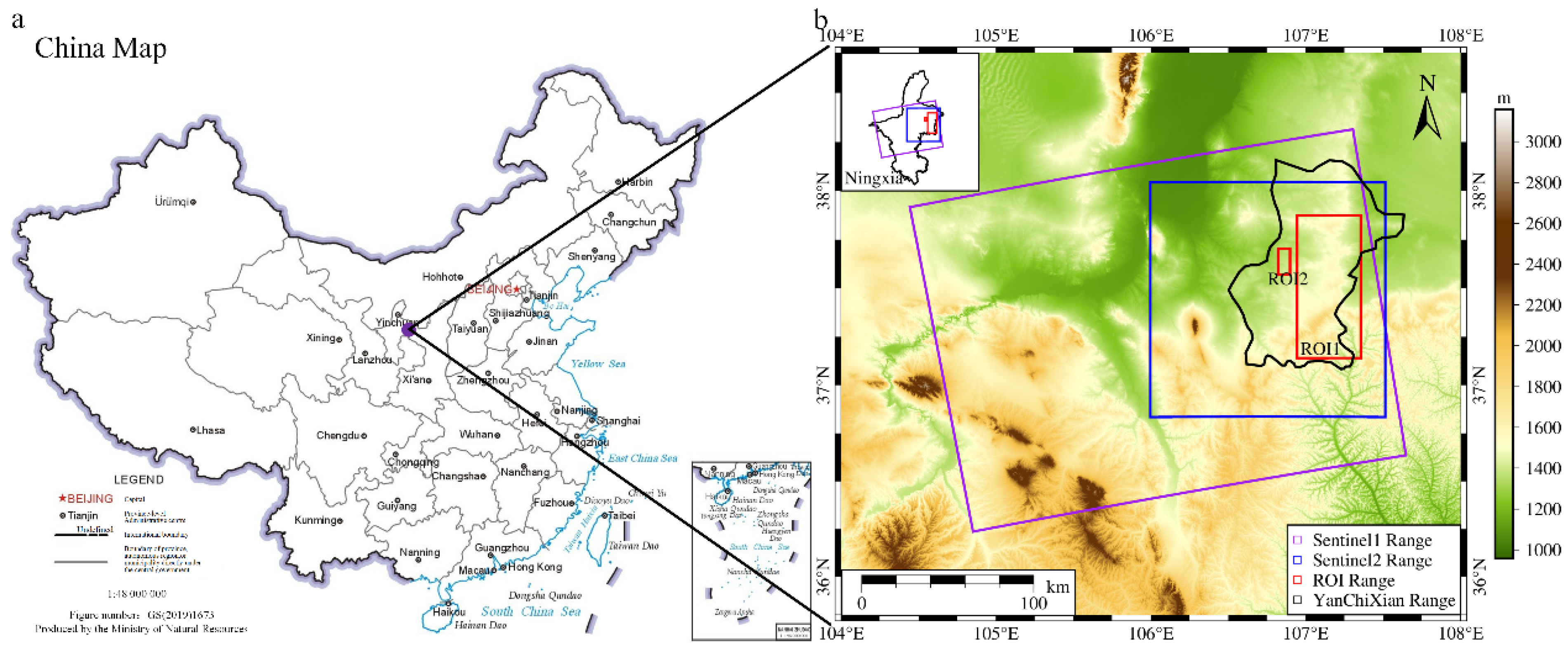

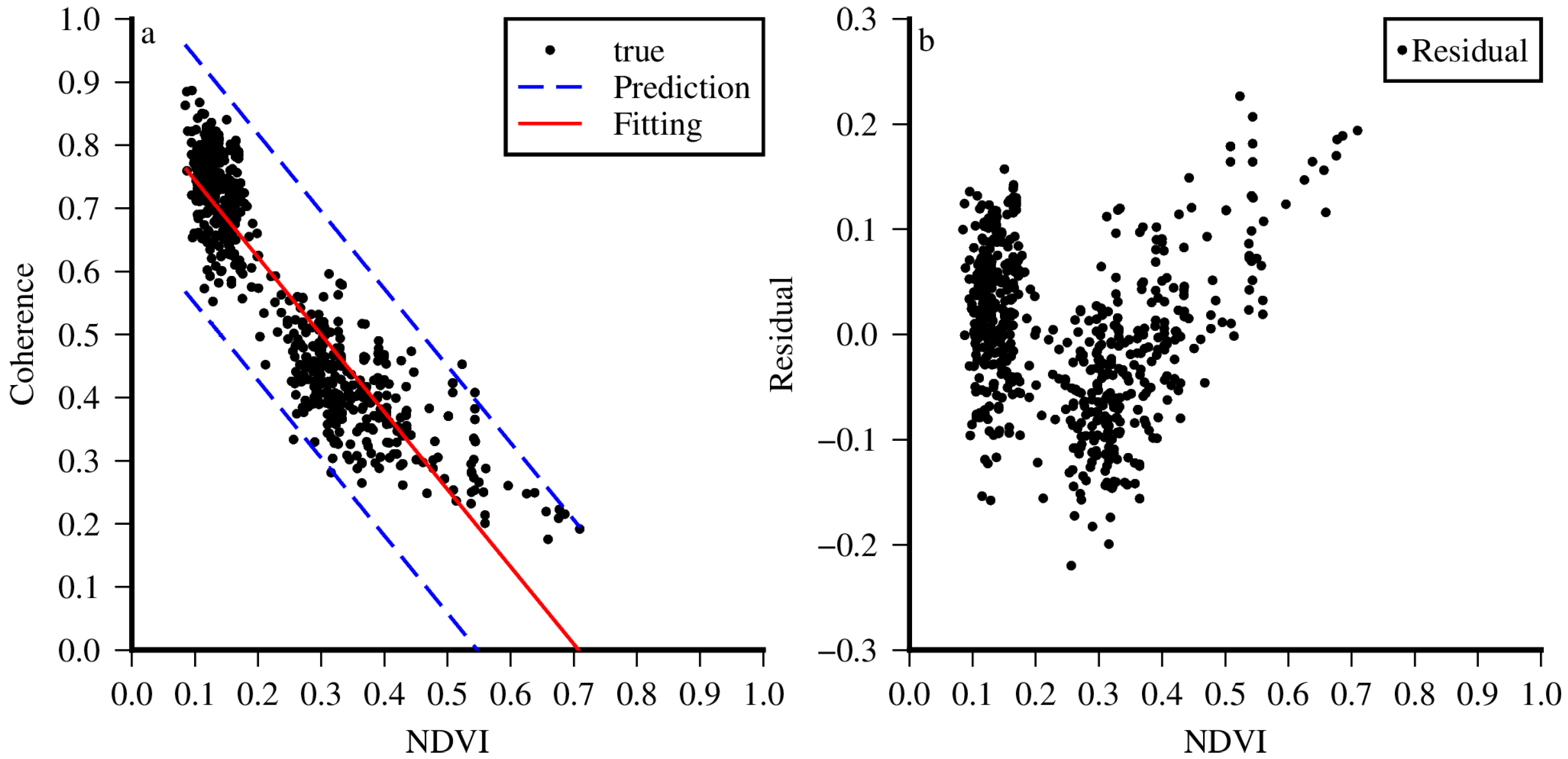
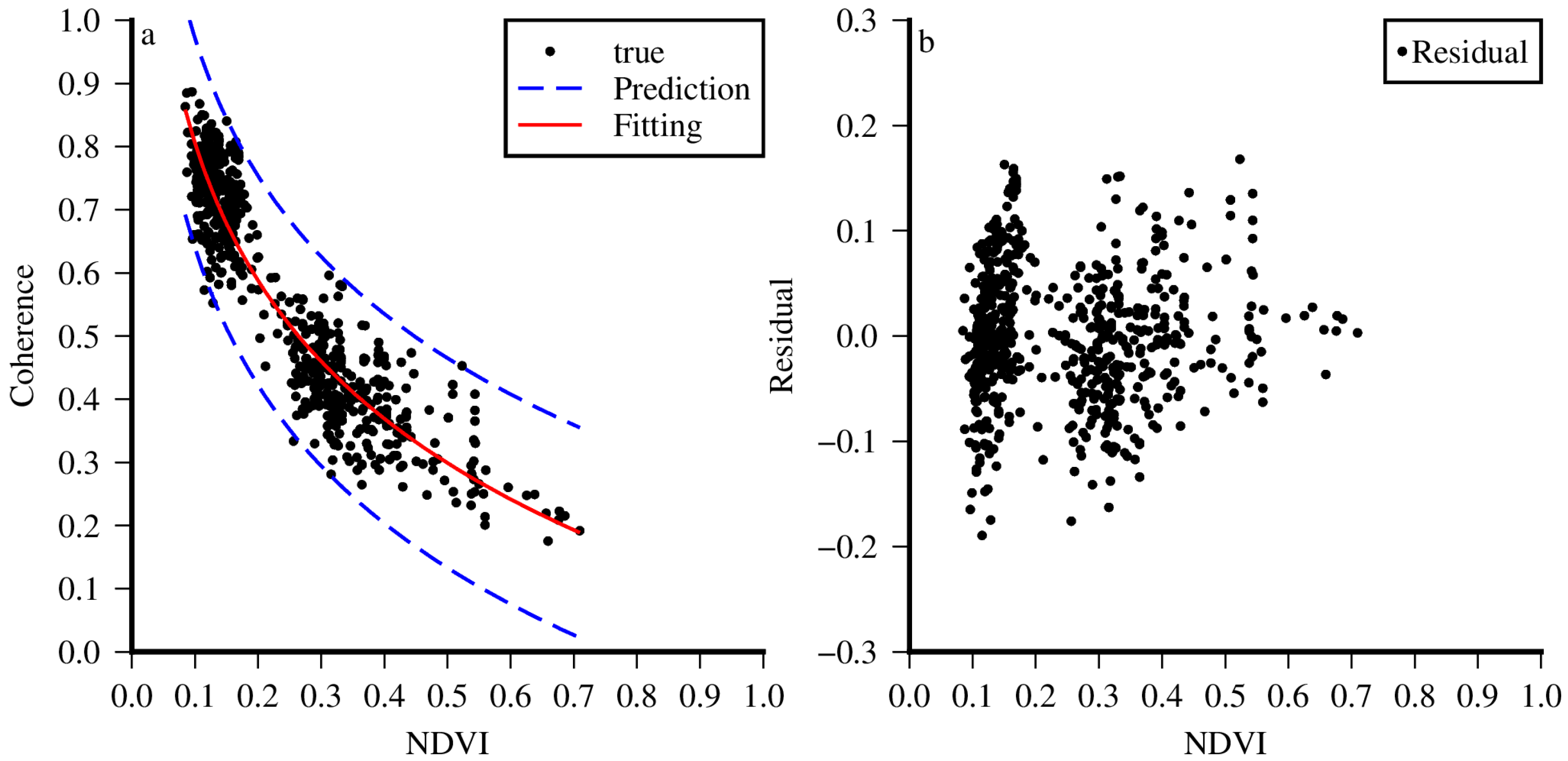
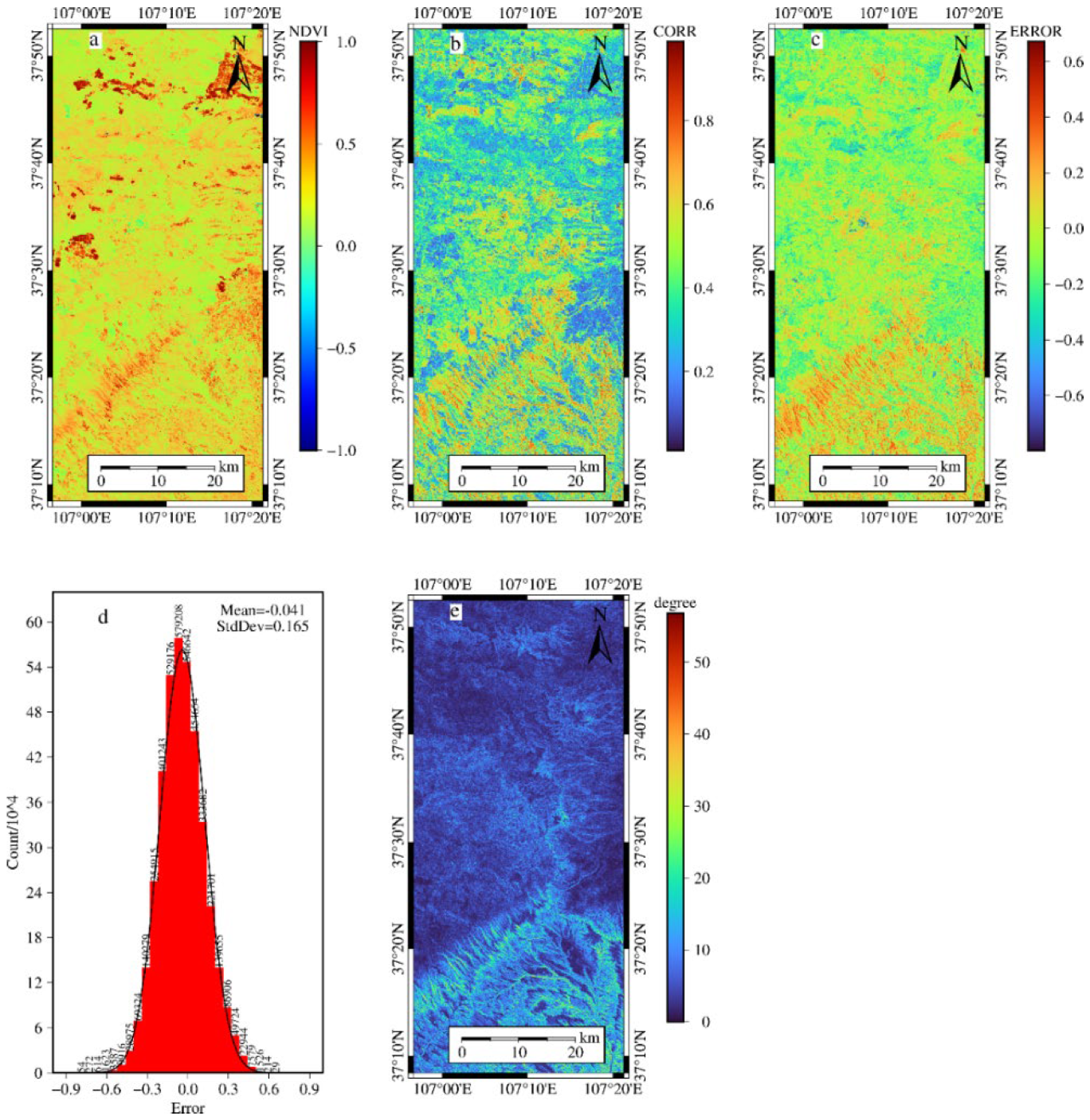

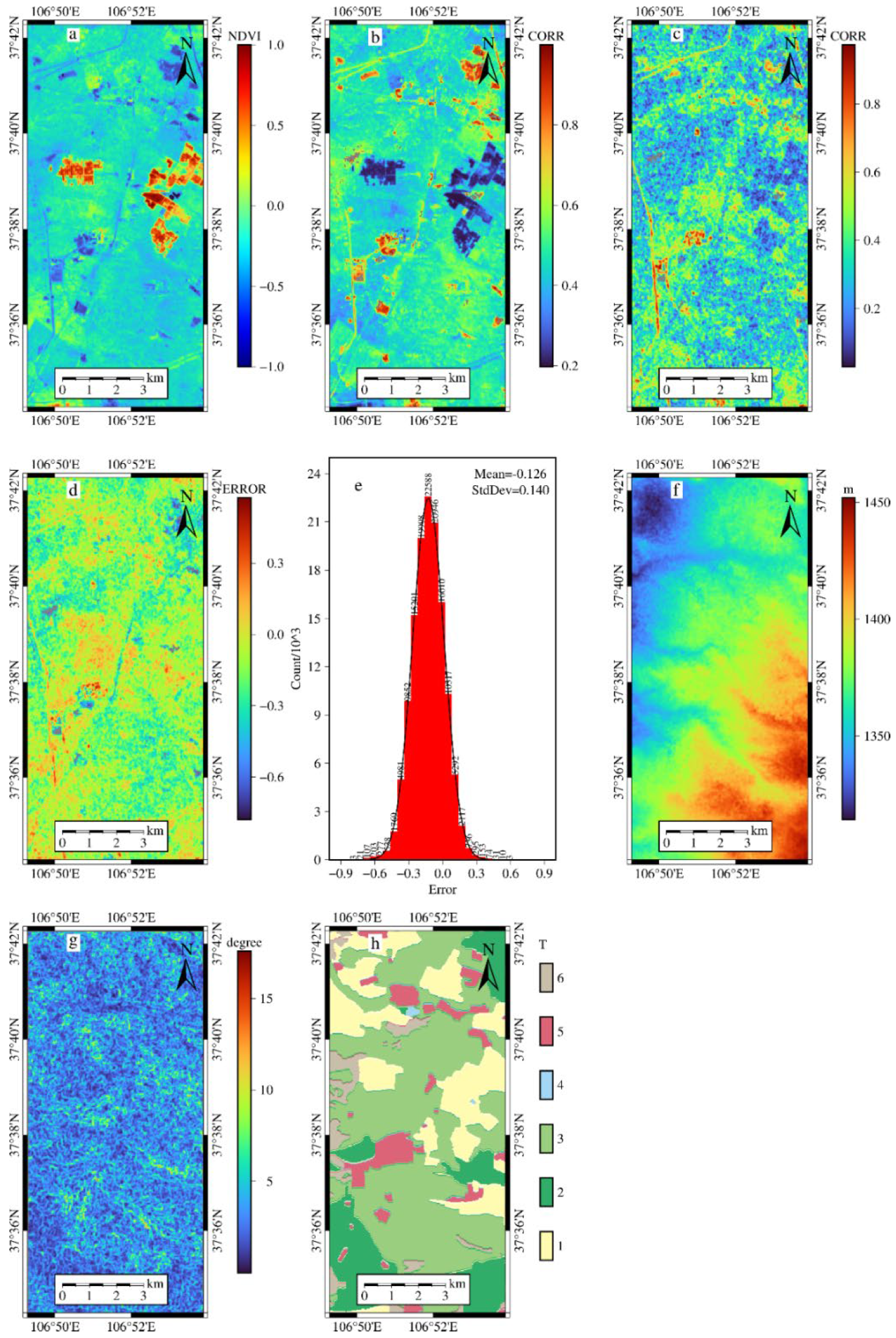
| Sensor | Band Number | Band Name | Sentinel-2A | Sentinel-2B | Resolution (meters) | ||
|---|---|---|---|---|---|---|---|
| Central Wavelength (nm) | Bandwidth (nm) | Central Wavelength (nm) | Bandwidth (nm) | ||||
| MSI | 4 | Red | 664.5 | 30 | 665 | 30 | 10 |
| MSI | 8 | NIR | 835.1 | 115 | 833 | 115 | 10 |
| Fitting Curve | ||||
|---|---|---|---|---|
| 0.06272 | 0.8767 | 99.52 | 0.3249 | |
| 0.07551 | 0.8207 | 99.36 | 0.3908 | |
| 0.06407 | 0.8711 | 99.36 | 0.3316 |
Publisher’s Note: MDPI stays neutral with regard to jurisdictional claims in published maps and institutional affiliations. |
© 2022 by the authors. Licensee MDPI, Basel, Switzerland. This article is an open access article distributed under the terms and conditions of the Creative Commons Attribution (CC BY) license (https://creativecommons.org/licenses/by/4.0/).
Share and Cite
Cao, Y.; Li, P.; Hao, D.; Lian, Y.; Wang, Y.; Zhao, S. Analysis of the Relationship between Vegetation and Radar Interferometric Coherence. Sustainability 2022, 14, 16471. https://doi.org/10.3390/su142416471
Cao Y, Li P, Hao D, Lian Y, Wang Y, Zhao S. Analysis of the Relationship between Vegetation and Radar Interferometric Coherence. Sustainability. 2022; 14(24):16471. https://doi.org/10.3390/su142416471
Chicago/Turabian StyleCao, Yuxi, Peixian Li, Dengcheng Hao, Yong Lian, Yuanjian Wang, and Sihai Zhao. 2022. "Analysis of the Relationship between Vegetation and Radar Interferometric Coherence" Sustainability 14, no. 24: 16471. https://doi.org/10.3390/su142416471





